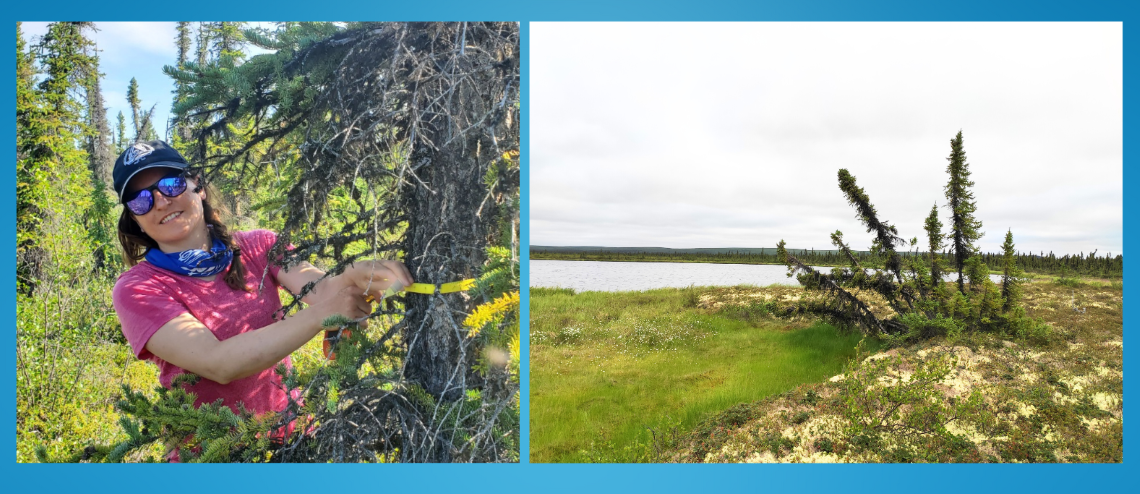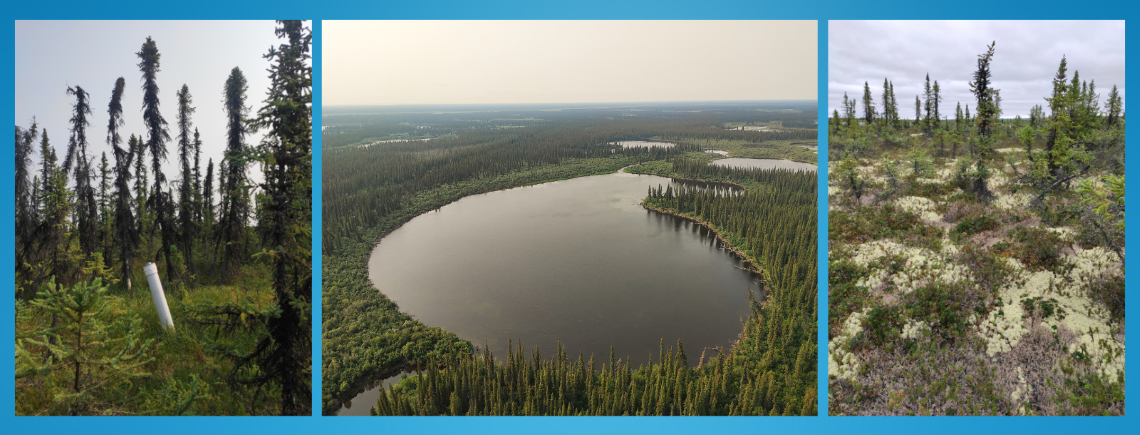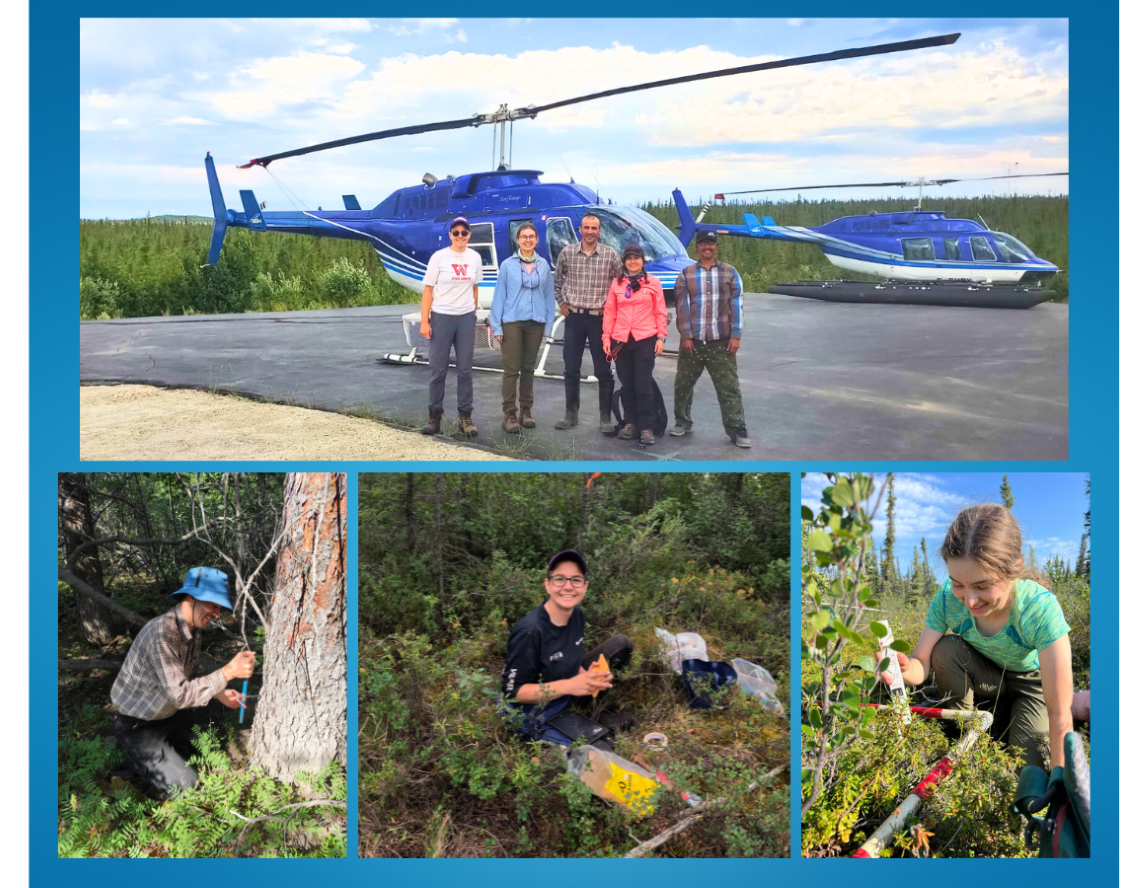What bent-out-of-shape trees reveal about climate change, permafrost melt and carbon storage
May 2025
By Matthew Gutsch for Simply Science
Deep in Canada’s northern forests, a strange phenomenon is taking root — a natural disorder known as “drunken trees.” These trees, warped and leaning at precarious angles, seem as though they’re in a state of perpetual, near-falling-down inebriation.
But what’s causing this bizarre, otherworldly tilt? The answer may surprise you: it’s a complex dance between nature’s harsh conditions, changes in the climate and the trees’ struggle to survive. Researchers are finding that, beneath the surface, a deeper story is unfolding — one of adaptation, the science of survival and the hidden ways life persists even in the most extreme environments.

Research scientist Raquel Alfaro Sánchez measuring the size of a tree trunk in a black spruce–dominated forest in the Northwest Territories. (Right) Drunken trees leaning over.
A puzzle hidden in the forest
Natural Resources Canada research scientist Raquel Alfaro Sánchez, PhD, is fascinated by these drunken trees — a peculiar sight that, on the surface, seems to belong more to folklore than science. But for Raquel, these crooked trunks aren’t just a curiosity, they’re a scientific puzzle. Based at the Northern Forestry Centre in Edmonton, Raquel is studying how these trees’ unsteady growth patterns might be affecting the broader ecosystem. Because these drunken trees may in fact be having a wider impact, one that goes far beyond their appearance — they could in fact be altering the very processes that regulate Earth’s carbon storage cycle.
You might be asking, what does that mean for the battle against climate change? Raquel is asking the same question. And with each step she takes to answer it, she’s drawn deeper into the mystery of how these forests — seemingly drunk on nature’s extremes — may be quietly shifting the balance of our planet and its future.

Trees adapt and struggle to stay upright as changing temperatures affect ground conditions in the Northwest Territories. This research work is supported by the Government of the Northwest Territories, Wilfrid Laurier University and Polar Knowledge Canada.
How do trees get tipsy?
“Drunken trees,” Raquel explains, “is a common expression for trees in a forest that are tilted in different directions.”
The physics for the phenomenon are simple: when permafrost thaws underneath the trees, the ground becomes unstable and causes the trees to shift and lean. This instability commonly occurs in the wet ground conditions where black spruce trees — also known as bog spruce and swamp spruce — are typically found. Studies have shown that the tilting is caused by variations in the annual cycle of thawing in spring and freezing in fall of the shallow ground layer, known as the active layer, where trees are rooted.
While this cycle is entirely natural, the rapidly increasing rate of permafrost thaw in recent decades is making the ground more unstable, leading to more extreme tree tilting. The culprit? Warming temperatures. The permafrost underneath the trees’ root system is thawing more rapidly, which leads to soil destabilization, and so they try to adjust by leaning. That’s what makes them appear drunken.
Unravelling the mystery
Raquel began studying drunken trees when she moved to Canada from her native Spain in 2020. She originally came here to study wildfires and post-fire forest regeneration with the possibility of analyzing tree rings during her postdoctoral degree at Wilfrid Laurier University in Waterloo, Ontario. She soon realized that the fire ecology she was familiar with in the Mediterranean is very similar to that in northern Canada. “We have some similar tree species that have similar responses,” she says. “So, for me, it was like, this is so cool. I’m going to study this in Canada.”
While at Wilfred Laurier, she came across a collection of tree rings from the Northwest Territories that had yet to be analyzed. She decided to examine these specimens and analyze their growth patterns. That’s when she discovered unusual patterns in the tree rings with darker areas of wood that indicated the trees were tilting and bending out of shape.
Curious, she wondered, “What is this? I normally don’t see these patterns, because in Spain, in Europe, you don’t have these problems with the soils. A tree’s rings are normally concentric, unless they are growing on slopes.” This realization led her to draw the connection between tree ring patterns, tilting trees and thawing permafrost. “I was like, What? Okay. It's very interesting,” she says. “I started analyzing more. A few studies had been conducted in the 2000s, but only in very localized areas, and nothing has uncovered such a latitudinal gradient as this.”

Raquel and her team travel to remote locations, such as the Northwest Territories, by helicopter. (Bottom row) Mehdi M. Aqdam sampling tree wood, Emma Sherwood collecting soil samples and Katerina Coveny measuring lichen cover.
The carbon connection
With this new insight into the processes underlying drunken trees, Raquel and her team are conducting research on the phenomenon and its impacts. “Our goal is to determine where forests are thriving and where they’re struggling,” she says.
The research is still at an early stage, but Raquel is already struck by the significance of her findings. They clearly show that the impact of thawing permafrost on tree growth has been intensifying dramatically over the past 40 years, with possible consequences for carbon storage. Drunken trees are using all their available nutrients and energy just to stay upright, while the ground beneath their roots is literally shifting and giving way. As a result, the trees have less energy to grow and to absorb the carbon they need.
“I was very surprised that our research results were so clear,” she says. “Growth is an equivalent measure of carbon absorbed — so less growth means less carbon stored within the trees.”
A changing forest, a shifting focus
This causal connection is strong and meaningful. “Normally in ecology, you don’t get very clear signals,” Raquel says. “This time, we found very significant results just by analyzing how tree growth declined with the number of leaning events — which is the variable that we are using to identify how affected the trees are.”
Looking to widen her findings, Raquel is now working with researchers in the Northwest Territories to identify where drunken trees are most affected and, more generally, to determine how different types and levels of permafrost degradation contribute to the phenomenon.
“We need to focus on northern forests,” she says. “They cover vast areas, and it’s essential to understand what’s going on there.” With climate warming causing an increase in local temperatures, some researchers are starting to hypothesize that there will be further changes in the north. “We need to understand if we’re seeing an increase or a decrease in productivity in the north,” she says. “With these types of studies — including the drunken trees — they’re each one piece of the puzzle.”
Looking ahead, she and her team plan to expand her work in the Yukon this summer, pairing tree ring data with longer-term permafrost records to better understand how Canada’s forests are adapting to rising temperatures. “By analyzing the tree rings, you have the history of the past,” she says.
While the drunken tree phenomenon still needs further study, one thing is certain: the ground beneath our feet is changing, and the trees are telling the story.
If you’re a member of the media or an educator and want more information about Raquel’s research or Simply Science, contact NRCan’s science communications team.
Explore:
Read more about Raquel Alfaro Sánchez’s research on Canada.ca and on ResearchGate
Article: Permafrost thaw brings major problems to Canada’s Northern Arctic communities
Simply Science video: Studying Permafrost in the Canadian Arctic
TreeSource – NRCan National tree ring database